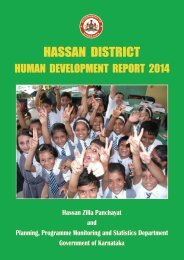Development
Raichur-DHDR-English-2014
Raichur-DHDR-English-2014
Create successful ePaper yourself
Turn your PDF publications into a flip-book with our unique Google optimized e-Paper software.
Raichur District Human <strong>Development</strong> Report 2014<br />
Of these, 314 were living in rural<br />
areas and 107 in urban areas.<br />
However, compared to the state, the<br />
proportion of houseless households<br />
was lesser. Thus, Raichur being a<br />
predominantly rural district, the<br />
problem is severe in the rural areas.<br />
Central and state governments have<br />
A typical Kaccha House taken measures to provide houses<br />
or support house construction, so<br />
that people can live in good houses.<br />
Based on a systematic identification<br />
of these households, there is a need<br />
to provide houses or facilities for<br />
construction of houses to these<br />
households.<br />
7.3. Site-less Households<br />
The first requirement for<br />
construction of a house is a<br />
residential site. Owing to shortage<br />
of suitable land, and sometimes, the<br />
cost of residential site many<br />
households do not possess a site<br />
for house construction. Apart from<br />
this, even today there are large<br />
Figure 7.1: Site-less Households in Raichur District, 2011-12<br />
Source: ZP, Raichur<br />
numbers of migrant communities,<br />
especially in urban areas, who do<br />
not reside at a fixed place. It is one<br />
of the factors for such people being<br />
deprived of government schemes<br />
and assistance. Therefore, house<br />
sites should be provided to site-less<br />
households and provide assistance<br />
to construct houses to houseless<br />
households. As far as information<br />
on site-less households and<br />
number of sites allotted is<br />
concerned, the data is not reliable<br />
and adequate. Because of this,<br />
there are problems in identification<br />
of genuine beneficiaries for<br />
provision of house sites.<br />
Rajiv Gandhi Rural Housing<br />
Corporation and the district<br />
administration together implement<br />
the schemes relating to house and<br />
site allotment. The data provided by<br />
these agencies is given in Figure<br />
7.1.<br />
For the district as a whole, 11 per<br />
cent percent of households are<br />
reported to be site-less. This is a<br />
huge proportion and when applied<br />
to the 2011 census data, the<br />
number works out to 41,625<br />
households. Across the taluks,<br />
Manvi reports the highest<br />
proportion of households (17 per<br />
cent) without sites, followed by<br />
Sindhnur and Devadurga (14 and<br />
13 per cent, respectively). The figure<br />
also depicts the percentage<br />
households provided with house<br />
sites by the Government. At the<br />
district level, hardly 2 per cent of<br />
the households have been provided<br />
with house sites as at the end of<br />
150



